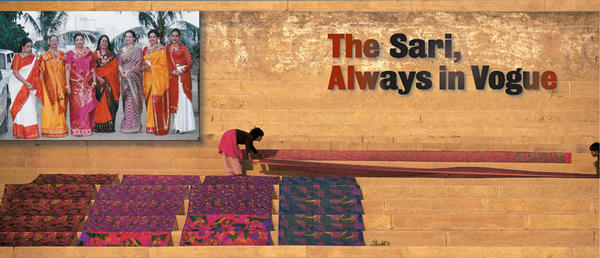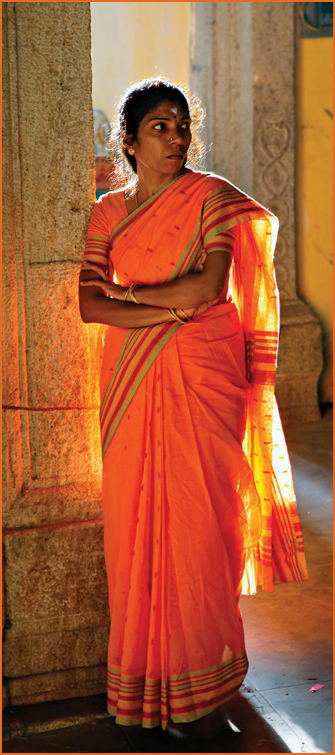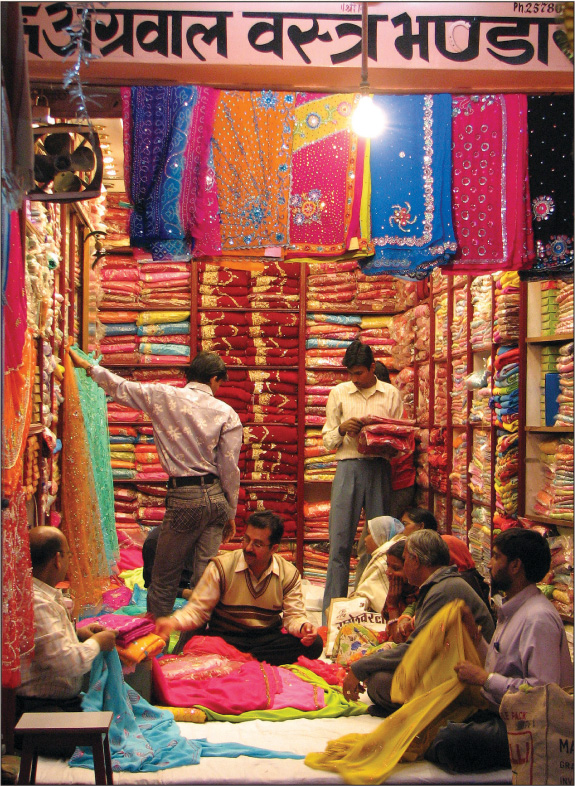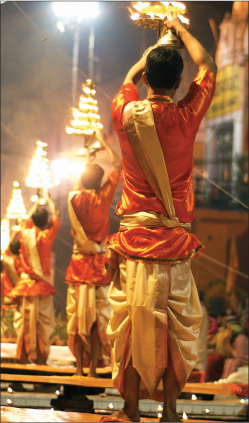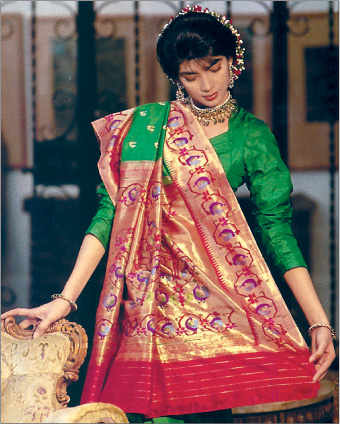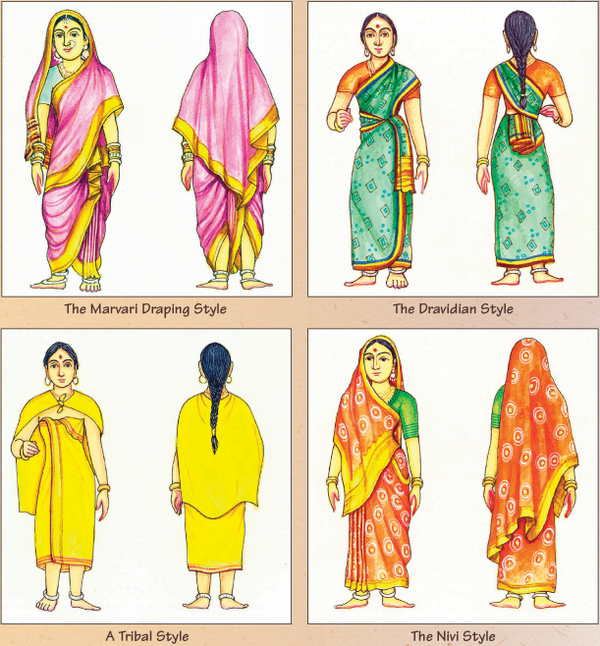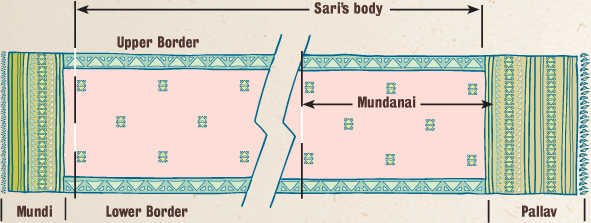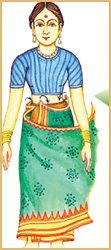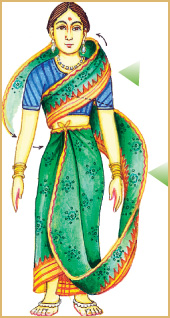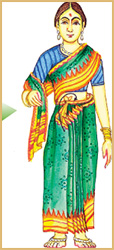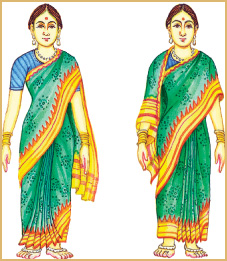Traditional and modern, the garment of India tours the world in flying colors
_________________________§
BY LAVINA MELWANI, NEW YORK§
![]() t a big society wedding in delhi, everyone was dressed in the latest budget-busting designer outfits, yet all eyes were on a young girl dressed in a rich, bluish-pink Varanasi sari with intricate floral motifs. This one-of-a-kind cloth had cost her nothing, for it had been part of her mother’s trousseau thirty years ago. Instead of having gone stale and out of style with age, it was the cynosure of all eyes, a treasure which had grown more valuable with time. §
t a big society wedding in delhi, everyone was dressed in the latest budget-busting designer outfits, yet all eyes were on a young girl dressed in a rich, bluish-pink Varanasi sari with intricate floral motifs. This one-of-a-kind cloth had cost her nothing, for it had been part of her mother’s trousseau thirty years ago. Instead of having gone stale and out of style with age, it was the cynosure of all eyes, a treasure which had grown more valuable with time. §
Who would have thought that six yards of fabric could be a synonym for elegance, beauty and style? The sari is the world’s longest-running fashion story, as relevant today as it was hundreds of years ago. While the sari shares space in a modern woman’s wardrobe with the popular salwar kameez (also known as the Punjabi suit, consisting of trousers and a long top) and Western pants, it is still the garment of choice for many, be it a washerwoman, an urban working woman or a high-society socialite.§
While Western dress has made inroads into almost every Asian culture, with traditional garments like the Japanese kimonos and Chinese cheongsams being reserved for ceremonial wear, the sari is a living garment, a part of the daily lives of women in the Indian subcontinent, from Nepal to India, Pakistan, Bangladesh and Sri Lanka. Practical and always in style, it is a forgiving garment that conceals a woman’s imperfections and enhances her special qualities. Even for a young, 21st century girl, draping a sari for the first time is the ultimate coming-of-age experience.§
THOMAS KELLY§
Weaving apprentices stretch six-yard lengths of newly made saris to dry on the steps along the river Ganga in Varanasi. Inset, at a wedding in Mumbai, seven women from India, Asia and the US show off their treasured attire outside the Jhole Lal temple. Each wears a distinctive design and draping style.§
Author and folk-art historian Jasleen Dhamija describes in her book, Handwoven Fabrics of India, how “The most intimate element in a person’s external being is the cloth with which one wraps oneself or one’s loved ones. It is also closely associated with inner life and the stages through which a person passes. Though the rituals are similar, their enactment and the fabrics used in them are quite distinctive. Saris were bought during the Dipavali festival, and the whole family participated in the yearly visit of the family weaver to the house, for saris traditionally were never bought off a shelf.§
“Weavers came from the weaving centers of Thanjavur, Kumbhakonam, Kanchipuram and Dharamavaram, bringing samples of new designs, colors and different qualities of silk. Families of weavers worked over generations with large joint families. Every village or center had a distinct style which a connoisseur could distinguish.”§
While the sari lives on in villages and cities, young innovative designers in India now give it fresh life and a new twist for the new generation. In India there are about 15 established labels, such as Rohit Bal, J.J. Valaya, Rina Dhaka, Suneet Varma, Tarun Tahiliani, Sandip Khosla and Ritu Kumar. These designers have revitalized the sari, adding heavily embroidered blouses to plain cloth, or re-styling the pallav (the portion of the sari which covers the bodice and falls over the shoulder) to give a new look to the sari. There’s even been the zip-on sari for girls who may have trouble handling all those pleats! At fancy weddings many women drape the sari in Gujarati style or seeda (straight) pallav (the pallav is taken from the back to front instead of being taken from front to back)—considered high style by the fashion-conscious.§
India’s designers, adroit in Western styles and fashion, still take great pride in ethnic traditions, and their offerings often echo embroideries and designs of earlier craftsmen, celebrating India’s cultural heritage. There are designer saris with scenes from the Mahabharata or Ramayana embroidered on the pallav (the ending border of the sari), or entire village portrayals in Bengali kantha work (running stitch embroidery used on decorated quilts). There is a kind of visual poetry in these saris, which are often woven by Muslim artisans for Hindu brides. Some of the best embroiderers in India are Muslim, who can even reproduce the intricate pieta dura work found on the Taj Mahal. Saris tell stories—of the Ramayana, of folk lore and mythical heroes and carry verses from the Vedas. Ganesha—the auspicious one—is popular on sari pallavs.§
As Indians have spread around the world, they have taken the sari with them. Saris are a common sight in London, Johannesburg, Trinidad, Toronto, San Francisco, Hong Kong and Singapore. In places as far flung as Mauritius and Nigeria, saris are a part of the landscape. In fact, saris are big business in countries like Hong Kong, Singapore and Japan, countries that produce bolts of synthetics like chiffon, satin and nylon which are bought in six-yard lengths by Indians to use as saris. These are also exported to many countries and find their way to the Little Indias of the US, UK and Dubai.§
HENK JACOBS§
Luminous elegance: It’s 7am in the Madurai Meenakshi Temple. A local pilgrim basks in the early sunlight’s mellow glow. A perfect example of the modern nivi drape, which has become a universal style for Indian women.§
Saris in America: Sari shops thrive in many Indian enclaves in America. Among the largest is India Sari Palace in New York, with a vast inventory from India as well as Japan. Many Indian communities here, such as the Gujarati, wear mostly saris, so there is a constant demand. Just looking at the stores in Little Indias across the nation indicates the sari is thriving. In the 60s, many women were reluctant to wear saris in the US, afraid they would stand out. But in today’s multicultural America, there seems to be a growing pride in one’s ethnic roots. While some Indian women working in corporate society may still prefer to wear Western dress to fit in, others in less structured jobs—film editors, writers, travel agents—often wear salwar kameez or saris to work.§
Many especially wear saris to evening events. After all, there is nothing quite as graceful as the sari, especially for evening wear. While styles and lengths of the salwar kameez fluctuate with alarming regularity, a sari is always in style. Traditional saris from different regions have a beauty all their own and are timeless.§
Kavita Lund, a wife, mother and accountant living in New York, has a sizable collection of saris and enjoys the grace it imparts. She, like most of her friends, wears the more practical pants and salwar kameez during the day and saves the saris for special occasions and evening events. Her 19-year-old daughter, Monisha, born and brought up in the US, is just as fascinated by saris, though she wears only the trendy designer styles. These modern incarnations of the sari would probably make any great-grandmother faint—the stomach is completely exposed and the pallav is wrapped nonchalantly around the neck, leaving the bodice bare. Dr. Manjula Bansal, a pathologist at the Hospital for Special Surgery and the Cornell University Medical Center in New York, has a large collection of saris from every part of India and wears them with great pride. Even when she was a medical resident, she wore a bindi on her forehead and saris to her workplace, riding on the subway. Now she wears the more practical salwar kameez to work, but always dresses in saris for social events, be it an Indian or a mainstream gathering.§
Bansal, who was involved with funding of the India Chair at Columbia University and with other mainstream cultural organizations, finds her sari a great ice-breaker at international gatherings. Her treasured saris are always great for conversation. She says, “Not only is a sari beautiful, but it is a story in fabric, depicting religious and social beliefs, and it shows good omens for a good life. Every craftsman puts his identity into it. You don’t have to be beautiful to feel beautiful in a sari. It brings out your inner beauty and grace.”§
So many styles: In all countries, dress usually indicates religion, social position, ethnicity, wealth and regional origin. While this is still mostly true in India, some urban Indian women and those living abroad do wear a cross-section of saris from different regions, and are certainly more Indian than regional in their perspectives.§
Women have a rich array of saris to choose from, including handloom saris from Andhra Pradesh, Tamil Nadu and Karnataka, silk brocades from Varanasi and Kanchipuram, jamdani (fine, transparent cotton muslin) from West Bengal, cotton saris from Kota in Rajasthan, patolas (elaborate, five-color design) and ikat (special dye process) from Gujarat, Rajasthan and Madhya Pradesh. For those living abroad, a trip to India means a new wardrobe, since the variety of fabrics in Indian cities is so vast.§
Interestingly enough, just as there are fakes in art and jewelry, there are fakes in saris. Today it’s easy to be taken for a ride because technology has improved so much. For example, saris with artificial gold look identical to those with real gold threads, the difference in price being a hefty Rs. 10,000 at least.§
Advances in India’s textile technology have made saris more affordable and easy to maintain for working women. Synthetic saris made in powerful industrial mills are attractively priced and don’t need heavy ironing or care. The flip side is that this has endangered the livelihood of village craftspeople who can take many months on a loom to produce a single sari. As one old weaver told Bansal when she visited his dilapidated, almost shut-down workshop, “People are impatient nowadays, and they can get ten machine-made saris for the price of one hand-woven sari. They don’t want to wait or spend the money.”§
India’s Ten Top-Selling Saris
![]() NDIA REMAINS THE BEST PLACE IN THE WORLD TO SHOP FOR SARIS. Rajiv Malik of Delhi, our HINDUISM TODAY correspondent and an expert in fabrics, composed this list of ten most popular saris after consulting with Mr. Vishnu Manglani, a leader in India’s national sari business. Prices are in US dollars. §
NDIA REMAINS THE BEST PLACE IN THE WORLD TO SHOP FOR SARIS. Rajiv Malik of Delhi, our HINDUISM TODAY correspondent and an expert in fabrics, composed this list of ten most popular saris after consulting with Mr. Vishnu Manglani, a leader in India’s national sari business. Prices are in US dollars. §
1 Gadwals: Cotton with separately woven and attached silk borders and pallavs. Made in Andhra Pradesh. $25–130.§
2 Tanchois: Pure silk with intricately woven pallavs and borders. Variety of designs used. Made in Varanasi. $130–400.§
3 Bumkais: Silk yarn, made in Orissa. Yarn is dyed so that, when woven, patterns appear in various colors. $20–125.§
4 South Handlooms: Like Kanjivarams, but they cost less. Bangalore made. Jari and silk borders and pallavs. $90–300.§
5 Printed: Silk, hand printed on three materials: silk, crepe and chiffon. Comfortable for party or home wear $65–130. §
6 Tangails: Fine cotton, hand-woven in Calcutta. Traditional Bengali designs. It gets softer with each washing. $10–100.§
7 Cotton Handlooms: Hand-woven in Coimbatore. Elegant for summer wear. Rich and crisp. Need much care. $20–50.§
8 Valkalams: Pure silk, woven in Varanasi to depict folk art scenes. Special handlooms can weave 25 colors. $90–400.§
9 Kanjivarams: Finest handloom silk, specialty of Tamil Nadu. Also called heirlooms. Pure jari-woven borders. $130–1500.§
10 Chanderis: Made with silk and cotton yarn in Madhya Pradesh. Saris are lightweight, ideal for summer. $20–125.§
Fads and experiments: Recently the New York Fashion Institute of Technology showed the 1940s saris of Princess Niloufer, an Ottoman princess who married the son of the Nizam of Hyderabad. She made the traditional sari her own by giving it a Western touch through decoration and the placement of motifs. Her saris were ornamented with sequins, beads and metallic embroidery on chiffon, crepe and net, with the floral designs falling in the front or over the left shoulder. Many of these saris were designed by a Frenchman, Fernande Cecire, and embroidered in India. This is reminiscent of the days of the British Raj, when Indian princesses traveled to Paris and had saris designed by French couturiers.§
Saris, with their golden threads, intricate embroidery and innate romance, have always attracted Westerners. Glimmerings of Indian inspiration appeared in the West in the 1920s when Madame Gres, a renowned Paris designer, showed sari-inspired styles in her collection. Western passion for Indian fashions can be traced to the British Raj, when socialites in London, New York and Paris were smitten by Indian fabrics and embroidery. Famous Western designers were deeply influenced. Those who have used saris and Indian fabrics in their collections include Mary McFadden, Oscar de la Renta, Jean-Paul Gaultier, Norma Kamali and Anna Sui.§
Manly drape: Young men performing Ganga Puja at Dasaswamedh Ghat on the banks of India’s holy Ganga River in Varanasi§
Recently, British designer Paul Smith did an entire collection based on India, including men’s shirts created out of saris. When Indian designer Rohit Bal’s mother saw this collection, she said plaintively to her son, “What’s all this nonsense about? I used to make shirts like this for you when you were young, and you never wore them!” To which Bal retorted, “I’m sorry, mom, but that was you. This is Paul Smith!”§
While some Westerners fashion saris into everything from pillow covers to tablecloths to evening dresses, others actually wear them, a memento of their Indian adventure. Some designers use it to outrageous effect. John Galliano was once spotted at a society gala in New York wearing a silk sari with a short tuxedo jacket and dress shoes. Supermodel Naomi Campbell wore a sari at the MTV Music Awards, and Goldie Hawn, a great fan of India, often wears saris to social events. The Duchess of York was presented with a green Varanasi silk sari by Prince Andrew. Legendary ceramist Beatrice Wood, who died at 105, wore nothing but saris and Indian jewelry for the last several decades of her life. And pop icon Madonna is very much into Indian saris, mehndi and meditation in her CD, “Ray of Light.”§
High fashion: A Vama fabrics model displays the opulent refinement of the maker’s elegant weaves§
For mainstream Americans, the sari is still an exotic garment, a costume to transport them to another world. In fact, Magic Markers Costumes, a Halloween costume supply house in Huntington, West Virginia, offers a sari for rental, along with blouse and petticoat, for US$45. Their website: www.magicmakers.com, shows an American woman draped in a sari.§
Fads come and go, but the sari survives them all. As Bansal points out, “One wants to be noticed, especially in a crowd, but why ape the West? The sari creates an instant identity for you, and I think that’s what most people are looking for, whether you are a CEO or a physician or you’re trying to make a mark. The sari says a lot about you.”§
The Remarkable Indian Art of Draping
While there are many detailed studies of India’s textile and sari-making industries, only one recent study has focused primarily upon the diverse ways saris are worn. In 1997, French anthropologist Chantal Boulanger [see her story on page 64 ] published a landmark work, Saris: An Illustrated Guide to the Indian Art of Draping. Her efforts are a significant step towards categorizing and preserving sari draping styles, some of which may be known only by a few elderly ladies in each region. The following overview is drawn from her work. See page 62 for definitions.§
BY CHANTAL BOULANGER, FRANCE§
![]() HE MOST ANCIENT RECORDED INDIAN DRAPE, EXCLUDING those of the Harappa civilization, is a dhoti. Buddha’s lay followers, such as Ashoka and the men and women represented on the stupa of Bharhut (Madhya Pradesh, 2nd century bce), wore elaborately pleated dhotis. Nowadays, dhotis are still worn by men all over India. They require a piece of cloth which seems longer and larger than what was worn in the past, but their pleating is often simpler, and they are no longer adorned with belts. There are several styles which reflect personal taste and/or occupation, such as the classic, priest, Andhra, Marwari and the Chettiyar dhotis. §
HE MOST ANCIENT RECORDED INDIAN DRAPE, EXCLUDING those of the Harappa civilization, is a dhoti. Buddha’s lay followers, such as Ashoka and the men and women represented on the stupa of Bharhut (Madhya Pradesh, 2nd century bce), wore elaborately pleated dhotis. Nowadays, dhotis are still worn by men all over India. They require a piece of cloth which seems longer and larger than what was worn in the past, but their pleating is often simpler, and they are no longer adorned with belts. There are several styles which reflect personal taste and/or occupation, such as the classic, priest, Andhra, Marwari and the Chettiyar dhotis. §
In the past, women wore dhotis just as men did. But from the 14th century onwards, women’s clothes started to develop in a very different way from those of men. The number of yards required increased and the shawl that sometimes covered the shoulders was transformed into the upper part of the sari—the mundanai. By the 19th century, the colonial attitudes imported from Victorian Britain considered dhotis to be indecent for women, and women in some castes modified the drape so that it covered their chest.§
Dravidian saris, which are the basis of the modern sari, are draped in two parts. The veshti (from the Sanskrit verb vesh, meaning “to cover,” “wrap around” or “to roll”) covers the lower part of the body. It is supplemented by a separate mundanai or mundu. The draping of the veshti is simple and virtually universal. Most people all over the world use this drape to wrap a bath towel around themselves. Various forms of veshtis were worn in India, and are represented on many sculptures and paintings from numerous places as early as the 2nd century bce. Veshtis are commonly worn by men in India’s two southernmost states, and also by women in Kerala. It is a common drape in many countries of Southeast Asia.§
It was probably not earlier than the 19th century when women joined both pieces of cloth, thus creating many elaborate new drapes. The draping of Tamil saris did not change much from that of the veshti-mundanai, except that this new fashion had one big inconvenience. When walking, the sari was pulled upwards by the mundanai, revealing the legs. Women in each region of Tamil Nadu found their own solutions, and adapted their draping in order to remain “decent,” thus spawning a great variety of styles.§
Most saris fit into families, which means they follow certain basic ways of being draped. There are four main families: the dhoti family, the Dravidian sari, nivi saris and tribal saris. There are also sub-families and a few smaller families. The dhoti family includes men’s dhotis, women’s dhotis and South Indian Brahmin saris. Dravidian saris include veshtis, Tamil saris, Eastern saris and Santal saris. The nivi saris are modern saris, kaccha saris and upper kaccha saris (the Sanskrit word kaccha means “pleats” or “pleats tucked between the legs”). The tribal family consists of high veshti tribal saris and right-shoulder tribal saris. The smaller families are the Gond-related saris, Lodhi saris, drapes with nivi and Dravidian influences and unique saris. Some drapes could fit within two families, such as the Gauda sari, which is at the same time tribal and kaccha. On the other hand, several drapes do not fit anywhere.§
The drape which is now considered to be the Indian sari, called nivi, has never been represented on any ancient painting or sculpture. Whereas dhotis and veshtis were commonplace in the past, nivi saris seem to have been nonexistent. §
The nivi family is by far the most widespread. These saris are now worn all over India, as well as in Sri Lanka, Bangladesh and Pakistan, not to speak of the Indian communities living abroad. In Rajasthan, Punjab and Uttar Pradesh, where stitched clothes are traditionally worn, nivis are becoming increasingly popular. In Sri Lanka, it has become the compulsory sari of government employees, rather than the more typical Ceylonese sari. It has influenced Western stylists and evokes for most European women a vision of flowing beauty and elegance. §
Every drape requires a piece of cloth of a specific length and width. For instance, it is impossible to make a Marwari sari with six yards; nine yards are needed. Each region of India has developed textiles woven in the dimensions fitting the local drapes. But apart from the size of the cloth, almost all saris can be tied with any kind of textile.§
When at home or working, women wear cotton or synthetic fabrics. When going to a function or an event, they often dress up with a silk sari. Most of the time, the draping is the same whatever the textile. While there are festive and daily drapes, a festive drape can be worn with a beautiful silk, polyester or cotton sari, and one might wear an old silk sari with a daily drape.§
The four main families of sari drape: (clockwise from upper left) Marvari, Dravidian, Nivi and Tribal.§
Both textile and drape are independently influenced by fashion. Stylists are mostly concerned with the fabric and the form of the choli, or blouse, but sometimes the adventurous introduce new drapes, too. Cotton always provides the best sari drape. Once folded and tucked, cotton stays in place, and doesn’t require anything to hold it. For weighty or slick cloths, such as silk, a pin or a clip might be used to hold the pleats and to keep from having to readjust the drape all the time. Just as in painting or playing a musical instrument, it takes training and practice to wear a sari perfectly.§
Saris are fun to wear. They can be tried by anyone, and more styles can be created. They are the expression of women’s creativity, and there is for each woman one drape that suits her perfectly. Often it is not the modern sari. §
PHOTOS BY PARESH GANDH§
Stylish leaders: (Left) Dressed in a red, silk sari, Indra Nooyi, C.E.O of Pepsi, presents awards at the India Abroad Publisher’s Event in 2007. Indra was ranked by Forbes magazine as the fourth most powerful woman in the world and the number one most powerful woman in business. Recipient of the Special Award for Excellence, dressed in a yellow sari, was Renu Khator, president and chancellor of the University of Houston and its 56,000 students.§
Definitions
Choli: a usually tight-fitting blouse often worn with a sari.§
Dhoti: usually white, a five-yard long, four-foot high weave, normally made of light cotton, having little or no borders and pallavs. These are worn by men all over India, except in Tamil Nadu and Kerala where only Brahmins drape them.§
Lower border: the edge touching the feet when the sari is first tied.§
Mundanai: the part of the sari, starting from the pallav but significantly longer, that is thrown over the upper body. §
Mundi: a Tamil word meaning pallav, or border; the mundi is the pallav at the other end of the sari, less elaborate, where the colors of the body and the borders usually mix. Draping often begins with this pallav. §
Mundu: a smaller piece of cloth often used to cover the head or thrown over the shoulder. This word usually translates as towel.§
Pallav: the most decorated end-part, which is thrown over the shoulder.§
Upper border: the highest border when the sari is first tied, generally used for the knot in closings.§
A sari’s two dimensions are length, which may range from two to nine yards, and height, which may range from two to four feet.§
Recommended resources: Saris: An Illustrated Guide to the Indian Art of Draping, by Chantal Boulanger, Shakti Press International, Post Office Box 267, New York, NY 10276-0267; The Sari: Styles, Patterns History, Techniques, By Linda Lynton, Harry Abrams Publishers, 100 Fifth Avenue, New York, NY 10011-6903; Ikat Textiles of India, by Chelna Desai, Chronicle Books, 275 Fifth Avenue, San Francisco, California 94118-2307; Clothing Matters: Dress and Identity in India, By Emma Tarlo, University of Chicago Press, 5801 South Ellis Avenue, Chicago, Illinois 60637.§
Draping a Sari
![]() f the more than eighty styles of sari drapes documented by Chantal Boulanger, the nivi sari is the most widely used style in the world. The following instructions are from her book, Saris: An Illustrated Guide to the Indian Art of Draping. For newcomers to draping saris, here is a word of advice from Sheela Venkatakrishnan of Chennai.§
f the more than eighty styles of sari drapes documented by Chantal Boulanger, the nivi sari is the most widely used style in the world. The following instructions are from her book, Saris: An Illustrated Guide to the Indian Art of Draping. For newcomers to draping saris, here is a word of advice from Sheela Venkatakrishnan of Chennai.§
“When you hold a sari out to wear the first time, you feel a mix of shock and surprise! How does so much go around and how does it stay in place? Then, someone who knows how it is done steps in, asks you to just hold your arms out, goes around you a couple of times, puts a pin here and a pin there and a few short minutes later, it is done. Now you want to learn to do this on your own. While it does help to have a person assist you, illustrations and instructions also work, mixed with a little imagination and a vivid recall of women in saris… and there you have it! A new look for a new you!”§
1 §
This sari is draped counter-clockwise. Start by making a knot on the right side of the abdomen with the upper corner of the mundi and the upper border, after passing it around the waist.§
All nivi saris start from the same basis, with little differences when tucking the pleats. All modern saris require six yards of cloth. If a petticoat is worn, an alternative to tying a knot for the closing is to tuck the upper corner of the mundi in the petticoat on the right side of the abdomen.§
2 §
Take the upper border, pass it and tuck it around the waistline counter-clockwise, making a small pleat first on the left hip, and then on the right hip. Finally tuck the upper border over the middle or the left side of the abdomen (depending on whether you want the front pleats to fall straight or in a fanlike shape).§
Most women tuck the pleats over the right side of the abdomen, so that they fall in the middle, but others tuck them in the middle, their fall being over the left side. If the pleats are to fall really straight, the first and last ones should be larger, and a small pleat should be made on the right hip before the main pleats, toward the right.§
3 §
Pass the sari around the body once, let it fall and take the pallav to drape the mundanai. It is essential not to follow our instinct to drape the sari from one end to the other, since the front pleats—the most characteristic part of nivi saris—are made with the cloth left between the drape of the sari’s closing and its mundanai.§
4 §
Take the pallav, either pleated in height or by its upper corner, pass it (at the waistline level), across the back and just under the right arm (in the armpit). Throw it from under the right arm to over the left shoulder, pulling it long enough to be able to come again across the back, under the right arm and to the left side of the abdomen.§
5 §
Once the mundanai is draped around the upper part of the body, a length of sari should be falling in front, between the closing (or the tucking) and the drape of the mundanai at its tightest. Take the upper border of this part and pleat it towards the inside, starting from that which is closest to the closing. Once the whole length is pleated, tuck it over the abdomen, pleats towards the left.§
The length of the mundanai is determined by the way each woman likes to drape it. Some let the pallav fall from the shoulder only to the waistline in the back. Others leave it down to their feet. What I have described here is the way most ordinary women wear it on usual days, when they tuck the pallav back in the closing over the left side of the abdomen. There is no absolute rule for the drape of the pallav; it is only a question of personal taste. Two common styles are shown below.§
